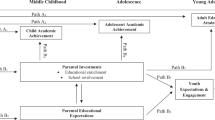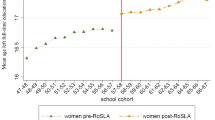Abstract
African American children are more likely to be poor and live in households that are “asset poor,” with no or very little net worth. Using the Panel Study of Income Dynamics and its Child Development Supplement, this article explores whether living in a household with net worth above the sample median seems to promote educational success and the development of human capital over time, irrespective of income. Controlling for parental income and education, as well as gender, household wealth in the form of net worth was the best predictor of parental expectations, high school completion, and college enrollment for young African American adults. A brief discussion of possible asset-building policy options follows.




Similar content being viewed by others
References
Beverly, S., & Sherraden, M. (1999). Institutional determinants of saving: Implications for low-income households and public policy. Journal of Socio-economics, 28(4), 457–473.
Beverly, S., Sherraden, M., Cramer, R., Williams Shanks, T., Nam, Y., & Zhan, M. (2008). Determinants of asset holding. In S.-M. McKernan & M. Sherraden (Eds.), Asset building and low-income families (pp. 89–151). Washington, DC: Urban Institute Press.
Blau, F. D., & Graham, J. W. (1990). Black-white differences in wealth and asset composition. Quarterly Journal of Economics, 105(2), 321–339.
Bowles, S., Gintis, H., & Osborne Groves, M. (2005). Unequal chances: Family background and economic success. New York: Russell Sage Foundation.
Caner, A., & Wolff, E. (2004). Asset poverty in the United States, 1984–1999: Evidence from the panel study of income dynamics. Review of Income and Wealth, 50(4), 493–518.
Conger, R. D., Ge, X., Elder, G., Lorenz, F., & Simons, R. (1994). Economic stress, coercive family process, and developmental problems of adolescents. Child Development, 65(2), 541–561.
Conger, R. D., Wallace, L. E., Sun, Y., Simons, R. L., McLoyd, V. C., & Brody, G. H. (2002). Economic pressure in African American families: A replication and extension of the family stress model. Developmental Psychology, 38, 179–193.
Conley, D. (1999). Being black, living in the red: Race, wealth, and social policy in America. Berkeley, CA: University of California Press.
Conley, D. (2001). Capital for college: Parental assets and postsecondary schooling. Sociology of Education, 74(1), 59–72.
DeNavas-Walt, C., Proctor, B., & Lee, C. (2006). Income, poverty and health insurance coverage in the United States: 2005. Washington, DC: U.S. Census Bureau.
Destin, M., & Oyserman, D. (in press). From assets to school outcomes. Psychological Science.
Diaz-Gimenez, J., Quadrini, V., & Rios-Rull, J.-V. (1997). Dimensions of inequality: Facts on the U.S. distributions of earnings, income, and wealth. Quarterly Review, 21(2), 3–21.
Duncan, G., & Brooks-Gunn, J. (1997). Consequences of growing up poor. New York: Russell Sage Foundation.
Fairlie, R., & Sundstrom, W. (1999). The emergence, persistence, and recent widening of the racial unemployment gap. Industrial and Labor Relations Review, 52, 252.
Farley, R. (1996). The new American reality: Who we are, how we got here, where we are going. New York: Russell Sage Foundation.
Gramlich, E. M. (2007). Subprime mortgages: America’s latest boom and bust. Washington, DC: Urban Institute Press.
Haveman, R., & Wolff, E. N. (2000). Who are the asset poor? Levels, trends and composition, 1983–1998. St. Louis: Center for Social Development, Washington University.
Hoffman, K., & Llagas, C. (2003). Status and trends in the education of blacks (NCES 2003–034). Washington, DC: U.S. Department of Education, National Center for Education Statistics, Government Printing Office.
Johnson, T., Kim, J., & Adams, D. (2008). Mapping the perspectives of low-income parents in a Children’s College Savings Account program: Individual and institutional factors. SEED research report. Lawrence, KS: School of Social Welfare, University of Kansas.
Keister, L. A. (2000). Race and wealth inequality: The impact of racial differences in asset ownership on the distribution of household wealth. Social Science Research, 29(4), 477–502.
Lareau, A. (2003). Unequal childhoods: Class, race, and family life. Berkeley, CA: University of California Press.
Leigh, W. A. (2006). Wealth measurement: Issues for people of color in the United States. In J. Nembhard & N. S. Chiteji (Eds.), Wealth accumulation and communities of color in the United States (pp. 23–66). Ann Arbor: University of Michigan Press.
Lui, M., Robles, B., Leondar-Wright, B., Brewer, R., & Adamson, R. (2006). The color of wealth: The story behind the U.S. racial wealth divide. New York: New Press.
Mason, L. M., Clancy, M., et al. (2007). SEED account monitoring research: Participants and savings outcomes at June 30, 2007. St. Louis, MO: Center for Social Development, Washington University.
Mayer, S. E. (1997). What money can’t buy: Family income and children’s life chances. Cambridge, MA: Harvard University Press.
McLoyd, V. C. (1997). The impact of poverty and low socioeconomic status on the socioemotional functioning of African-American children and adolescents: Mediating effects. In R. Taylor & M. Wang (Eds.), Social and emotional adjustment and family relations in ethnic minority families. Hillsdale, NJ: Lawrence Erlbaum.
Mulligan, C. B. (1997). Parental priorities and economic inequality. Chicago: University of Chicago Press.
Oliver, M. L., & Shapiro, T. M. (2006). Black wealth/white wealth: A new perspective on racial inequality (10th ed.). New York: Routledge.
Oliver, M. L., & Shapiro, T. M. (2008, October). Sub-prime as a black catastrophe. The American Prospect, 19(10). Available at: http://www.prospect.org/cs/articles?article=sub_prime_as_a_black_catastrophe.
Orr, A. (2003). Black-white differences in achievement: The importance of wealth. Sociology of Education, 76(4), 281–304.
Orzechowski, S., & Sepielli, P. (2003). Net worth and asset ownership of households: 1998 and 2000. Washington, DC: U.S. Census Bureau.
Peter, K., & Horn, L. (2005). Gender differences in participation and completion of undergraduate education and how they have changed over time (NCES 2005–169). Washington, DC: U.S. Department of Education, National Center for Education Statistics, Government Printing Office.
Scanlon, E., Buford, A., & Dawn, K. (2007). Matched savings accounts: A study of youth perceptions of program and account designs. SEED research report. Lawrence, KS: School of Social Welfare, University of Kansas.
Schreiner, M., & Sherraden, M. (2007). Can the poor save? Saving and asset building in individual development accounts. New Brunswick, NJ: Transaction Publishers.
Shapiro, T. M. (2004). The hidden cost of being African American: How wealth perpetuates inequality. New York: Oxford University Press.
Sherraden, M. W. (1991). Assets and the poor: A new American welfare policy. Armonk, NY: M.E. Sharpe.
Sherraden, M., Moore McBride, A., Johnson, E., Hanson, S., Ssewamala, F. M., & Shanks, T. R. (2005). Saving in low-income households: Evidence from interviews with participants in the American Dream Demonstration. St. Louis, MO: Center for Social Development, Washington University.
Spilerman, S., Lewin-Epstein, N., & Semyonov, M. (1993). Wealth, intergenerational transfers, and life chances. In J. S. Coleman, A. B. Sorensen, & S. Spilerman (Eds.), Social theory and social policy: Essays in honor of James S. Coleman (pp. 165–186). Westport, CT: Praeger.
U.S. Census Bureau. (2006). A half-century of learning: Historical statistics on educational attainment in the United States, 1940 to 2000 (Census 2000 PHC-T-41). Retrieved December 12, 2008 from http://www.census.gov.
U.S. Census Bureau, Current Population Survey. (2005). Annual social and economic supplement. Retrieved December 12, 2008 from http://www.census.gov.
U.S. Census Bureau, Current Population Survey. (2007). Annual social and economic supplement. Historical income tables—Household. Retrieved December 12, 2008 from http://www.census.gov.
Williams Shanks, T. R. (2007). The impact of household wealth on child development. Journal of Poverty, 11(2), 93–116.
Wolff, E. N. (1998). Recent trends in the size and distribution of household wealth. Journal of Economic Perspectives, 12(3), 131–150.
Wolff, E. N. (2001). Recent trends in wealth ownership, from 1983–1998. In T. M. Shapiro & E. N. Wolff (Eds.), Assets for the poor: The benefits of spreading asset ownership (pp. 34–73). New York: Russell Sage Foundation.
Zhan, M. (2006). Assets, parental expectations and involvement, and children’s educational performance. Children and Youth Services Review, 28(8), 961–975.
Zhan, M., & Sherraden, M. (2003). Assets, expectations, and children’s educational achievement in female-headed households. Social Service Review, 77(2), 191–211.
Author information
Authors and Affiliations
Corresponding author
Rights and permissions
About this article
Cite this article
Williams Shanks, T.R., Destin, M. Parental Expectations and Educational Outcomes for Young African American Adults: Do Household Assets Matter?. Race Soc Probl 1, 27–35 (2009). https://doi.org/10.1007/s12552-009-9001-7
Received:
Accepted:
Published:
Issue Date:
DOI: https://doi.org/10.1007/s12552-009-9001-7




